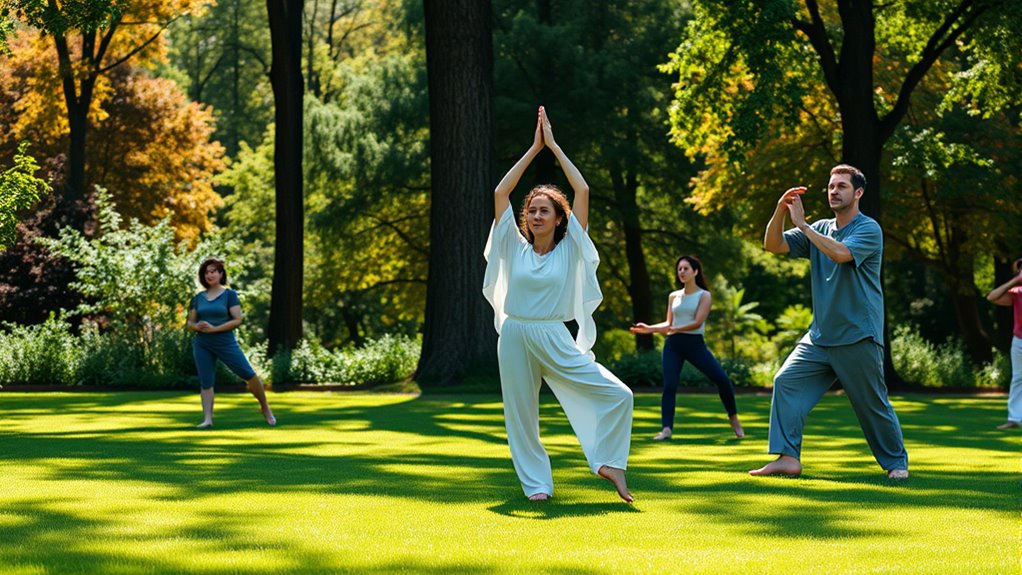Mind-body approaches like yoga and tai chi blend mental focus with gentle movement to boost your overall well-being. These practices help you connect with your breath and body, reducing stress and increasing resilience. They require minimal equipment and can fit into your daily routine, making them accessible and easy to sustain. By incorporating these techniques, you’ll improve your mood, sleep, and focus—discover more ways to integrate these powerful tools into your life.
Key Takeaways
- Mind-body approaches like yoga and tai chi integrate physical movement with mental focus to promote holistic health.
- These practices enhance relaxation, reduce stress, and improve emotional resilience through mindful movement.
- They often incorporate breathing exercises and meditation techniques to foster mental clarity and physical well-being.
- Regular practice can improve flexibility, balance, cardiovascular health, and overall physical fitness.
- Accessible and adaptable, these methods support long-term stress management and enhance quality of life.

Mind-body approaches are techniques that recognize the powerful connection between mental and physical health. When you incorporate practices like mindfulness meditation and breathing exercises into your routine, you tap into this connection, promoting overall well-being. Mindfulness meditation involves paying close attention to your thoughts, feelings, and bodily sensations without judgment. It helps you become more aware of stress triggers and teaches you to respond calmly rather than react impulsively. By focusing on your breath and the present moment, you can reduce anxiety and improve your emotional resilience. Breathing exercises, in particular, are simple yet effective tools that you can do anytime, anywhere. Deep, controlled breaths activate your parasympathetic nervous system, which helps slow your heart rate and lowers blood pressure, creating a sense of calm. Regularly practicing breathing techniques can also enhance your lung capacity and oxygenate your body more efficiently.
These practices don’t require special equipment or a lot of time. Even a few minutes of mindful breathing each day can make a significant difference. For instance, you might begin your mornings with a short session of mindfulness meditation, focusing solely on your breath as it moves in and out. As you become more comfortable, you can extend this practice or incorporate breathing exercises like diaphragmatic breathing or box breathing to deepen your relaxation. The key is consistency—making these practices a daily habit helps you develop greater awareness of your mental and physical states over time.
Integrating mindfulness meditation and breathing exercises into your daily routine can also improve your sleep quality, increase your focus, and boost your mood. These techniques help you cultivate a sense of presence and acceptance, which can be especially helpful during stressful moments. You’ll find that as you become more attuned to your body’s signals, you’re better equipped to manage tension and prevent stress from escalating. Over time, these mind-body techniques can develop into powerful tools for managing chronic conditions, reducing symptoms of depression and anxiety, and fostering a more balanced outlook on life. The beauty of these approaches lies in their simplicity and accessibility—once you learn how to harness your breath and mind, you carry those skills with you wherever you go, creating a foundation for long-term health and resilience.
Frequently Asked Questions
Are Mind-Body Approaches Suitable for Children and Teenagers?
You might wonder if these approaches fit children and teenagers. They often find these practices engaging and enjoyable, which boosts child engagement. Plus, many techniques are developmentally suitable, helping improve focus, flexibility, and stress management. When tailored appropriately, these practices can support their emotional and physical growth, making them a beneficial addition to a young person’s wellness routine. Always guarantee activities match their age and developmental stage for the best results.
How Do These Practices Compare to Traditional Medical Treatments?
You might wonder how these practices compare to traditional medical treatments. Complementary therapies like yoga and Tai Chi often support overall well-being but aren’t substitutes for medical care. Evidence comparison shows they can reduce stress and improve mental health, yet they lack the rigorous testing of conventional medicine. You should view them as helpful additions, not replacements, and always consult healthcare professionals for serious health issues.
Can Mind-Body Techniques Help With Severe Mental Health Conditions?
Think of your mind and body as a garden needing care—mind-body techniques can be the gentle rain that nurtures it. While they might not replace traditional treatments, they can markedly aid in holistic healing and stress reduction, helping manage severe mental health conditions. These practices work by calming your mind and strengthening your resilience, offering a complementary approach that empowers you to take an active role in your mental well-being.
What Are the Potential Risks or Contraindications?
When considering mind-body techniques, you should be aware of potential risks like physical limitations and medical contraindications. If you have injuries, chronic illness, or certain health conditions, these practices might worsen symptoms or cause discomfort. Always consult your healthcare provider before starting new techniques, especially if you have underlying health issues. Being cautious helps you safely enjoy the benefits while minimizing risks.
How Long Does It Take to See Benefits From These Practices?
You might wonder about the timeline benefits of regular practice. Typically, with consistent practice, you can start noticing improvements within a few weeks, especially if you practice several times a week. The more frequently you engage, the quicker you’ll see benefits like reduced stress or increased flexibility. Keep in mind, individual results vary, but maintaining a steady practice will help you experience positive changes over time.
Conclusion
So, here you are, thinking that slowing down with yoga or tai chi might not be enough to tackle life’s chaos. Ironically, these gentle practices could be your secret weapon, helping you find calm in the storm. Instead of chasing quick fixes, maybe it’s time to embrace the irony—by doing less, you might actually gain more peace. Who knew that sitting still could be the ultimate act of self-care?











